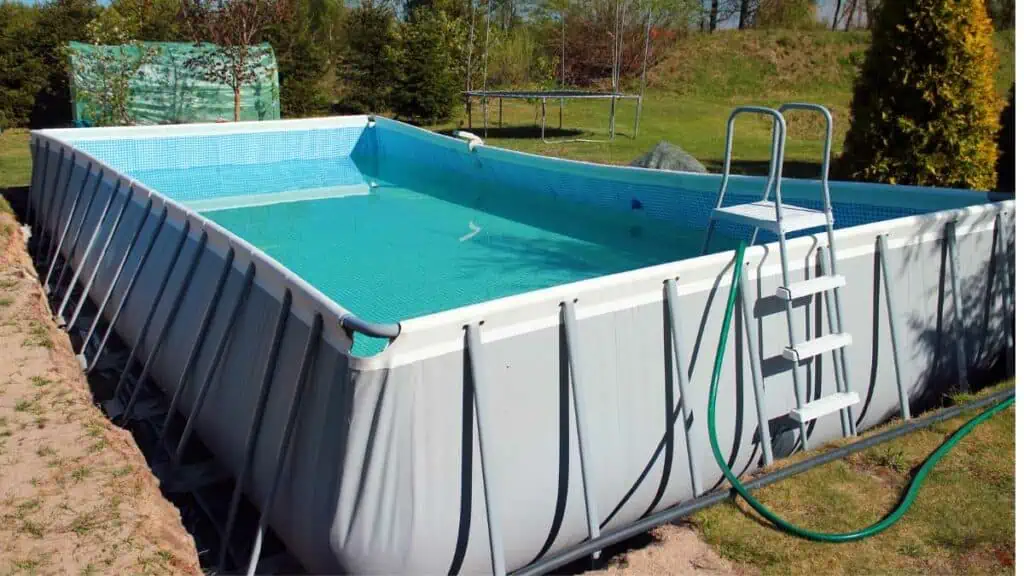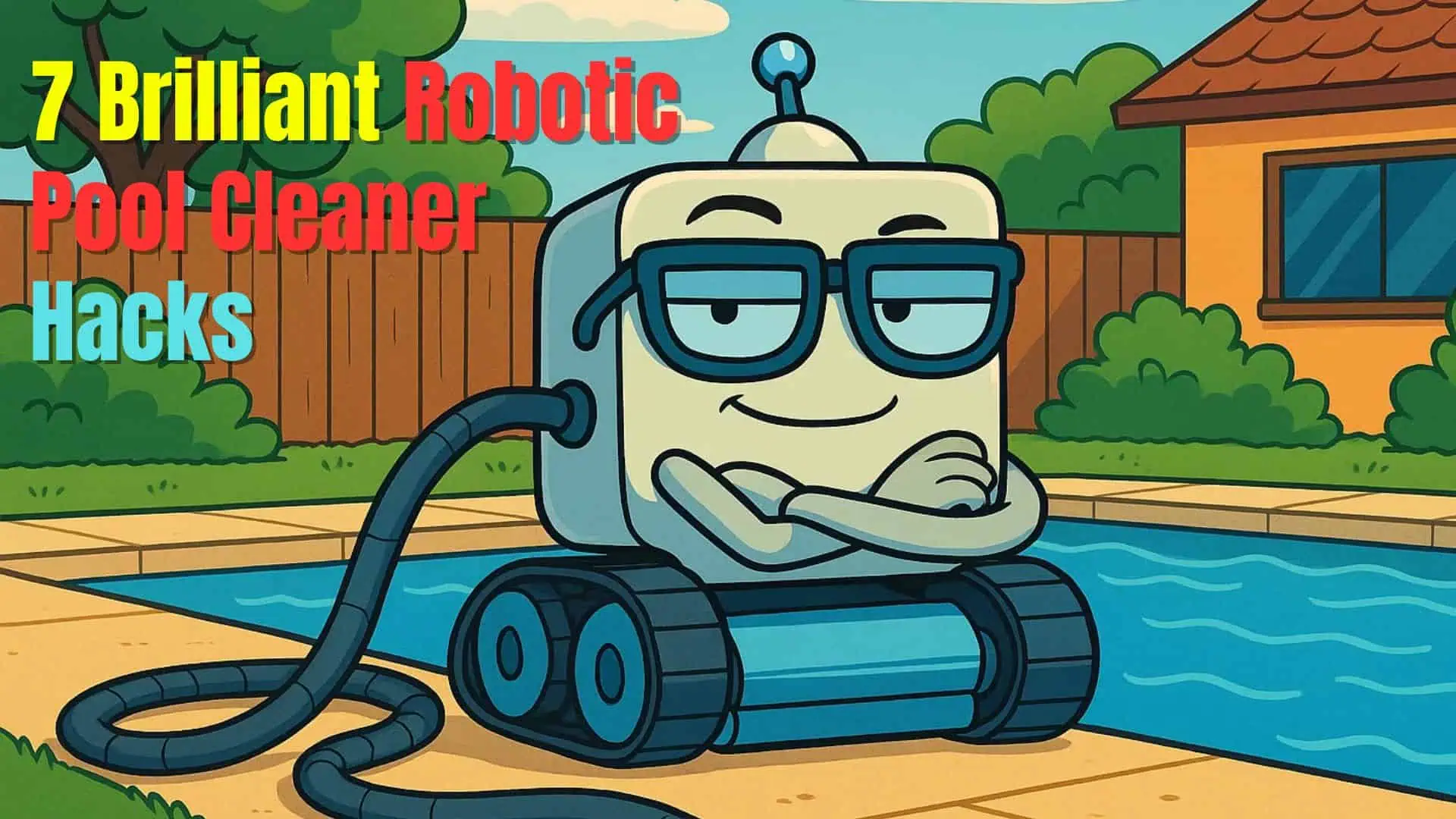Setting up an above-ground pool for those perfect summer dips is exciting, but it’s crucial to remember that the key to a sturdy and safe installation begins right at ground level – literally.
If your pool is not on a flat surface, it could lead to structural problems, uneven water distribution, or, worse, a potential collapse.
Yes, leveling the site can be a time-consuming process, but definitely, not a hard one, particularly if you have a fairly level yard.
We will walk you through the step-by-step process how to level ground for above ground pool. Whether you’re a do-it-yourself enthusiast or simply seeking to understand the process, this article has got you covered.

Choose the Location
Choosing the right location for your above ground pool is extremely important.
Firstly, gather details about whether the pool has to be placed at a particular distance from roads, septic tanks and property lines.
Avoiding roots, pipes, underground cables, power lines, etc. is equally important.
It is better if you choose a spot that doesn’t have overhead branches or trees. Having some shade around your pool is good, but several large trees will end up dirtying your pool, and you will have to clean it more frequently.
Select the flattest site in your backyard that will need the least amount of shoveling.
Also consider the level of privacy you need, and the level of security required to supervise your kids and pets are other factors to take into consideration.
Make sure there is proper access to water and power as well.
Prepare the Location
Once you have decided on the perfect spot for your pool, it is then time to prep the location for installation.
Leveling the ground for your above-ground pool is critical. An unlevel pool could result in uneven pressure on one side, causing potential structural damage or even collapse. Here are the steps to make sure the ground is level:
- Mark the Area: Using a stake, mark the center of where you want the pool to be. Measure the radius (half the diameter) of your pool size (assuming it is round) from that center point and mark your boundary using a string tied to the stake or use marking spray paint. If it is rectangular, mark out its dimensions with stakes.
- Clear the Area: Remove any rocks, sticks, roots, and other debris from this area. Also, make sure to strip away any grass and vegetation as these can puncture the pool liner and cause it to rot underneath the pool.
- Level the Ground: Start at the highest point within your marked area and dig down until you reach the level of the lowest point. It’s important to take away soil rather than add it to ensure the ground is compact and stable. Use a long, straight 2×4 and a carpenter’s level to continually check the levelness as you go along.
- Compact the Soil: Use a lawn roller or a plate compactor to compact the soil, making sure it’s firm to prevent any settling once the pool is filled with water.
- Add a Base Layer (Optional): Depending on your choice, you may want to add a base layer. See the section below about the best bases for a pool.
- Check the Level Again: Check the levelness one more time before installing your pool. This step is critical. If the ground is off by even an inch, it could result in serious damage or even cause the pool to collapse.
- Install the Pool: Now that the ground is prepared, you’re ready to install your above-ground pool according to the manufacturer’s instructions.

What should an above-ground pool sit on?
Here are some of the best surfaces to place an above-ground pool:
- Concrete slab or patio: Concrete provides a firm, level surface that can support the weight of the pool and the water. It’s one of the best options, although it can be expensive to install if you don’t already have a suitable concrete area.
- Compacted sand: Sand is often used under above-ground pools as it can be easily leveled and is relatively inexpensive. It’s soft, which can prevent damage to the pool liner, but it should be compacted well to prevent shifting.
- Compacted soil: If the soil in your yard is naturally level and free of rocks, it can potentially be used. You’ll need to remove all vegetation, compact the soil, and ensure it is level.
- Artificial turf: Artificial grass is an attractive, low-maintenance option that can be easily leveled. It can also be more forgiving than concrete or rock if the pool bottom comes into contact with it.
- Pavers: These can provide a solid, durable and flat surface for your pool. It’s important to ensure they’re level and that no sharp edges can puncture the pool.
- Commercial padding: This type of padding can be placed directly on level ground and can provide a soft base for your pool. It’s designed to protect the pool liner from stones, roots, or other sharp objects that could cause damage.
Also read: Can You Put an Above Ground Pool in the Ground?
Using a Professional
If you choose to hire a professional to have your above ground pool installed, you can be confident that the pool will be installed with proper measures.
They will make sure that the ground is leveled properly, all dirt is removed from the ground, sand is laid, and every other minute detail, so that you and your family get to enjoy your pool for years to come.
Seeking professional help is highly recommended if you are planning on installing a large sized above ground pool. But, there are people who hesitate to pay more money for installation, after having paid quite a large amount for the pool itself.
The cost associated with having a professional install your pool can vary based on different factors, like your location, the evenness of the ground, and of course, the size of the chosen pool. Roughly, it can cost you upwards of $1200 for a professional hand.
Try doing some research and making some calls to different pool installation service companies in your neighborhood to get their estimates.
FAQs
Why is it important to level the ground before setting up an above-ground pool?
Leveling the ground ensures equal distribution of water pressure on all sides of the pool, preventing structural damages and potential collapse. It also ensures the pool is safe for use
Can I level the ground for an above-ground pool myself?
Yes, with the right tools and physical effort, you can level the ground yourself. However, for larger pools or uneven terrain, you may want to consider hiring professionals to ensure proper leveling.
What tools will I need to level the ground for an above-ground pool?
Typically, you’ll need a shovel, a rake, a carpenter’s level, a tape measure, and a lawn roller or plate compactor. If you’re adding a sand base, you’ll also need a tamper to compact the sand.
What should I use as a base underneath my above-ground pool?
You can use a variety of materials, including compacted soil, compacted sand, commercial foam padding, a heavy-duty tarp, or even a concrete slab. The choice often depends on your budget, the type of pool, and personal preference.
I’ve finished leveling, but the ground is still not perfect. Is it okay to proceed with the pool setup?
No, the ground needs to be perfectly level before setting up the pool. Even an inch of difference can put significant stress on the pool walls, leading to serious damages or potential collapse. It’s important to take the time to ensure the surface is as level as possible before proceeding.





Leave a Reply